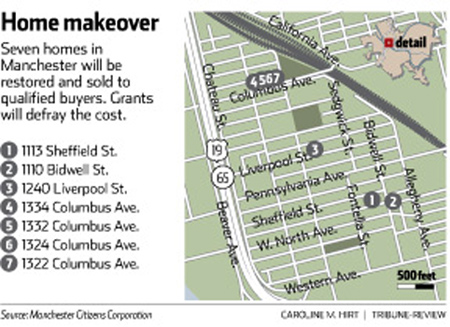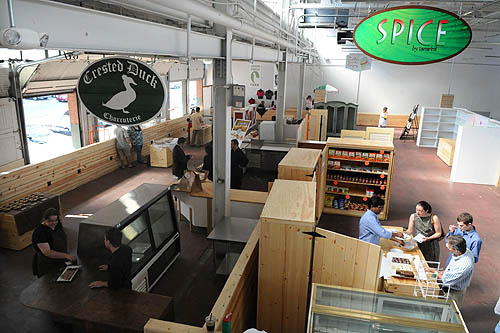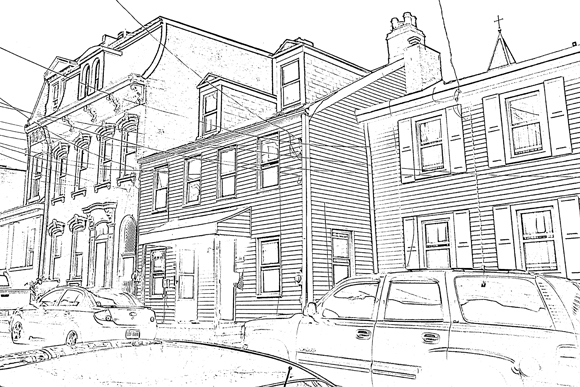
Category Archive: Landscapes
-
7 Homebuyers Sold on Manchester Vision
By Adam Brandolph
PITTSBURGH TRIBUNE-REVIEW
Thursday, September 2, 2010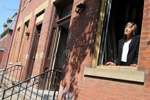
Linda Nelson, chairwoman of the Manchester Citizens Corporation, inspects one of the properties being restored on Columbus Avenue in Manchester. The home was purchased as part of the Great House Sale. Jasmine Goldband | Tribune-Review
For the first time in years, Anthony Clark sees a reason to invest in his North Side neighborhood.
“Manchester is really starting to get going, and after 15 years of renting, I think it’s a good time,” said Clark, 44. “I think we’re about to see some really great things.”
For years, the city demolished vacant homes in Manchester, turning usable buildings into weed-filled lots that became overrun with graffiti and trash. The vacant lots made selling homes difficult, and people living there say the community suffered despite the fact that police records show the number of crimes fell by nearly half over the past decade.
“When you have a tooth out, the disease begins to spread,” said Linda Nelson, chairwoman of the Manchester Citizens Corporation, a community group founded in 1965 that helped spur more than $40 million in developments and initiatives. “If (buildings) come out, it’s definitely a hindrance. If we can renovate them, it’s a plus.”
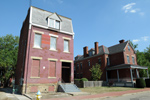
An abandoned structure (left) on the 1100 block of Bidwell Street in Manchester is one of several slated for rehabilitation. Jasmine Goldband | Tribune-Review
With the group’s managing director Stanley Lowe urging the city to save buildings from demolition, the wrecking ball slowed. Along with the Pittsburgh History & Landmarks Foundation, it identified 110 buildings that should be saved, 63 of which are considered a priority.
Lowe said he reminded members of the city’s Historic Review Commission about the neighborhood’s rich architectural and cultural heritage, which helped Manchester achieve city and national historic status in 1979.
“Once you tear down the building, you can never go back,” Lowe said.
In October, the citizens’ group showcased seven homes to be restored by March. More than 100 people, some from as far away as Venezuela and Colombia, attended a two-day session that included a seminar educating them about how to buy one of the homes.
Twenty-five people put down $1,500 deposits, and seven qualified buyers were chosen at random to buy the homes. The rest were put on a waiting list for future restorations.
“The homes were a terrible mess,” Nelson said. “But the people who came in saw our vision.”
The cost to restore each home will range from $150,000 and $450,000, but they will sell for $90,000 to $200,000.
Incentives totaling $2 million for the buyers will be paid by grants from the city’s Urban Redevelopment Authority, the federal Department of Housing and Urban Development, Allegheny County, the Pittsburgh History & Landmarks Foundation’s Landmarks Community Capital Corporation and the Allegheny Foundation.
City Councilman R. Daniel Lavelle, whose district includes Manchester, said the strategy “fits the city’s economic reality.”
“The city can’t afford to do it all at once, so (the citizens’ group has) identified key properties they want to save,” Lavelle said. “I think it’s a tremendous project.”
Preserving the “architectural fabric” of the historic district has been ongoing since the 1970s, said Arthur Ziegler, president of the landmarks foundation.
Rob Stephany, executive director of the redevelopment authority, said the restorations are a “really bright strategy,” especially because they’re near construction at Columbus Square, a $15 million, 31-home development on four acres.
“Manchester has everything working for it,” he said.
-
City’s Newest Indoor Market Opens in Strip Next Week
Wednesday, September 01, 2010By Diana Nelson Jones, Pittsburgh Post-GazetteWhen the Pittsburgh Public Market in the Strip opens Friday, patrons will see some tried-and-true faces — La Prima Coffee, the Common Plea and Fudgie Wudgie among them.
But the new indoor market in the Produce Terminal Building on Smallman Street marks the retail debut of a number of the 43 vendors, whose wares will include organic produce, coffee, specialty meats, pastries, Indian food, pierogies, organic teas, local wines, micro brewed beer, skin care products, knitted goods and jewelry.
The Produce Terminal was built in 1926 by the Pennsylvania Railroad. The market house, located between 16th and 17th Streets, features horizontal roof-line skylights and doors that open for a river view. It will be open Fridays from 9 a.m. to 7 p.m., Saturdays from 9 a.m. to 5 p.m. and Sundays from 10 a.m. to 4 p.m. The grand opening festivities are Sept. 10-12.
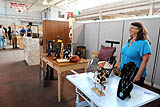
Debbie Jacknin of Jenn's Jems displays her jewelry and other items in her booth at the new Pittsburgh Public Market in the Strip District on Tuesday. Robin Rombach/Post-Gazette
The project began almost nine years ago as a dream of Neighbors in the Strip.
“Eight years, three months and two days,” said Tom Goslin, the Market Council president and owner of American Dispatch.
The dream got state funding in 2005, the same year the Urban Redevelopment Authority, which owns the building, did a feasibility study. The URA invested $100,000. The total price tag of $1.25 million was filled out by federal, state and local foundation money.
“This was part of our neighborhood improvement strategy,” said Becky Rodgers, executive director of Neighbors in the Strip. “It’s been a goal of ours to bring back a piece of history to Pittsburgh.”
The city once had four enclosed marketplaces. The last of them closed in 1965 to create Allegheny Center Mall.
Several years ago, the board of Neighbors in the Strip visited existing markets: the Reading Terminal Market in Philadelphia, the West Side Market in Cleveland and the Central Market in Lancaster, hoping to bring a similar concept to the Strip.
Cindy Cassell, market manager, said the market council selected vendors “in the context of the entire Strip. We had a series of meetings with existing businesses and came up with a list of things that would contribute the most diversity to the Strip.”
Edith Davis and Eartha Sewell, of Edith and Eartha Textiles, are among several woman- and minority-owned businesses in the marketplace. They were in a knitting group, then started knitting together, specializing in scarves and wraps.
“People said they wanted to buy them” said Ms. Sewell, “so we thought we could make a business out of it. Then this opportunity came up. You know what they say: Do what you love.”
The first vendor’s space in the markethouse is Kevin and Adam Costa’s Crested Duck Charcuterie, where the brothers are opening their first specialty meat shop. Kevin was mentored by a chef during a stint in Cincinnati, “then I just played with it and tried things. I did vegan baking at a farmer’s market in Indianapolis” before returning home to Pittsburgh last year.
Debbie Jacknin’s 23-year-old daughter Jenn began making jewelry when she was 14. “She taught me,” said Ms. Jacknin. “We’ve done craft shows before but nothing like this,” their first retail presence — Jenn’s Jems.
“A friend told me about this marketplace. I had to submit a video. And they accepted us.”
Diana Nelson Jones: djones@post-gazette.com or 412-263-1626. -
Public Market in Strip to Open Sept. 10, Feature Specialty Items
By Michael Machosky, PITTSBURGH TRIBUNE-REVIEW
Tuesday, August 31, 2010
Siblings (from left), Xanthe Schandelmeier, 5; Coco, 9; and Vivienne, 7, of Squirrel Hill, sample sweets at Prasad Potluri's Spice by Tamarind booth in the Pittsburgh Public Market. More than 40 vendors will showcase their wares in a 10,000-square-foot area of the Produce Terminal Building. The grand opening will be Sept.10. The market will be open Fridays, Saturdays and Sundays. Heidi Murrin | Tribune-Review
From homemade pierogies and duck pate with pistachios and fresh herbs to old-school Italian ice and locally-brewed beer — the Pittsburgh Public Market is so close, you can almost taste it.
“It will be 45 years in November since Pittsburgh had a public market,” said Becky Rodgers, executive director of Neighbors in the Strip, who vividly remembers the last one — the long-demolished North Side Market House. “My great uncle Bob was a butcher there. My whole family used to go — it was like a sight-sound-smell extravaganza.”
Starting with a soft opening Friday, the long-delayed Pittsburgh Public Market finally will open to the public. On Sept. 10, there will be a clamorous Grand Opening marked by the ringing of bells — the public is invited to bring their own to add the racket.
Unlike Pittsburgh’s seasonal farmers markets, this indoor market will be open every weekend year-round. The $1.3-milllion project will have more than 40 vendors in 10,000 square feet of space — which is only a small slice of the blocks-long Produce Terminal Building along Smallman Street, where it is housed. The entrance is near 17th Street.
It’s been a delicate balancing act from the start, which began in 2001. Spaces from 6,500 square feet to 30,000 square feet were considered. And finding a way to avoid diverting business from the Strip’s established food purveyors was a major concern.
“You’ll notice we don’t have a fish place in our market — that’s a very usual kind of thing to have in a market,” said Cindy Cassell, the market manager for Neighbors in the Strip. “We don’t have a cheese place. We’re really working hard not to replicate existing niche markets.”
Vendors quite literally are all over the map — from Gosia’s Pierogies to Sito’s Mediteranean dressings, to Ekh’s authentic Indian vegetarian dishes, to Mushrooms for Life, foraged from around Western Pennsylvania.
Kevin Costa was slicing up duck pate and “Gin & Juice Salami” Tuesday morning at the Crested Duck Charcuterie, a specialty meat market with a booth near the entrance.
“We wanted to start our own business, but it would have been impossible to duplicate the foot traffic of the Strip, so this is perfect,” Costa said.
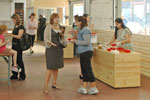
On Sept. 10, the PIttsburgh Public Market will open for business inside the Produce Terminal Building in the Strip District. More than 40 vendors will showcase their wares with everything from baked goods to artwork, barbecues to microbrews. Heidi Murrin | Tribune-Review
Starting a business is a lot less daunting for vendors when they’re paying $25 a day for a 10-foot-by-6-foot booth or $50 a day for a 10-foot-square booth.
“One of our challenges has been to get the concept across that, while this is not necessarily full-time, it’s also not a farmer’s market where you just show up and put your tablecloth down,” Cassell said. “It’s a little more permanent than that. So there is some planning involved for your booth. The booths are small, but from a financial perspective, I think it’s very accessible for a new business.
“We do have a lot of startups that are coming in,” she said. “That’s one of our goals, to incubate new businesses. And you know everything will be realized when they grow up and need a storefront, and can, hopefully, take an empty storefront in the neighborhood.”
Other vendors just want a little more visibility.
The Spice by Tamarind booth stocks Indian spices, snacks, chutneys, ready-to-eat meals and specialties like eggless cakes. Owner Prasad Potluri runs several Indian restaurants and small grocers in the region.
“It’s to make people aware of the restaurants and food,” Potluri said of the reason behind his participation.
For some, it’s simply a way to make it easier for customers to find their product.
Scott Smith, of East End Brewery, always assumed most of the sales for his Big Hop IPA and Black Strap Stout would be wholesale to bars and restaurants. But craft-beer fans just kept searching out the tiny, out-of-the-way brewery.
“We’re in an unmarked building in Homewood, and half our business is walk-in traffic,” Smith said.
Now, customers can sample Fat Gary Nut Brown Ale and Pedal Pale Ale at the Pittsburgh Public Market, and fill up their growlers to take home.
Not everything in the market is edible.
Babouche sells Moroccan crafts, jewelry, scarves and leather goods. Iron Eden is renowned for beautiful ironwork — flowers, trellises, sculpture — often made from recycled scrap metal. Jenn’s Jems features knit and crocheted items, and handmade jewelry.
Markets in other cities — like Cleveland’s West Side Market and Seattle’s Pike Place Market — have become first-day tourist attractions.
The Pittsburgh Public Market is starting on a much smaller scale, of course, but drawing new shoppers to the Strip is part of the plan.
“When we had Campos do a consumer market survey for us in 2006, at that time, we were planning for about 30,000 square feet,” Cassell said. “According to the consumer survey, it would add about 12,000 additional shoppers to the Strip every week. Now we’re scaled back in 10,000 square feet. But one of our goals is to increase the customer base for the entire Strip.”
Pittsburgh Public MarketWhen: Opens Friday, with Grand Opening Festivities Sept. 10-12
Hours: 9 a.m.-7 p.m. Fridays, 9 a.m.-5 p.m. Saturdays, 10 a.m.-4 p.m. Sundays
Where: 17th and Smallman streets, Strip District
Details: 412-281-4505 or website
-
E Properties & Development Restore Abandoned Lawrenceville Houses
Wednesday, September 01, 2010
E Properties and Development is nearing completion on the transformation of two blighted properties on 38th Street in Lawrenceville, contributing to the major revitalization efforts taking place on the hill between Butler Street and Penn Avenue.
The two connected townhouses at 234 38th Street sat neglected for some time, until E Properties and Development principal Emeka Onwugbenu purchased them last June.
“In terms of challenges, people suggested that the properties be demolished,” says Onwugbenu. “Our team of architects and engineers created value-based solutions that would restore the structural stability of each building while building on its architecture.”
Onwugbenu and architect Andrew Moss extended the foundations of the houses to create a more open environment with two added rooms, and installed bamboo floors throughout the buildings. They are also raising the second and third floors, and installing clear story windows, which will allow light to pour through the master bedrooms that will open into unique balcony decks overlooking downtown. The exterior, which is currently composed of vinyl siding, will be swapped out for cement board side material. Coldwell Banker has signed on to market the homes, which will start in the low $200,000 range, and are slated for move-in by Thanksgiving.
Onwugbenu, originally from Nigeria, attended Penn State for industrial engineering, and is currently in his final semester of the MBA program at CMU. He started E Properties and Development in 2007, in order to create unique value-added properties, which mix traditional design with a modern feel.
In addition to the homes at 234 38th Street, architect Andrew Moss is currently building his dream home one block away at 221 38th Street. Two other homes, at 236 and 238 38th Street, are currently being renovated by private owners, within steps of the 234 buildings.
Sign up to receive Pop City each week.
Source: Emeka Onwugbenu, principal of E Properties and Development
Writer: John FarleyImage courtesy Emeka Onwugbenu
-
Thank You Summer Interns
PHLF News
July 29, 2011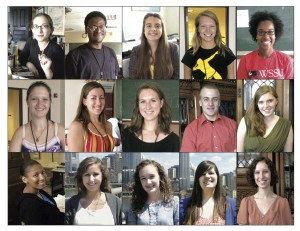
Since March, PHLF has involved 15 students (high school, college, and graduates) in its educational programs and preservation activities. As volunteers with PHLF, each student decides how many hours a week and what days h e/she is able to help out. Once here, interns assist with school tours, workshops for teachers, research and archival assignments, and main street programs. And, if they enjoy being with students, they help out with CampDEC, a 2 0-day adventure with middle school students in the Pittsburgh Public School’s Summer Dreamers Academy. Thank you everyone for your help and effort!
As a result of their experiences, interns add to their portfolios and gain a new (or deeper) appreciation for Pittsburgh’s architecture and history and for the economic, social, and cultural benefits of historic preservation. Intern comments on the value of their experiences include the following:
- Julie Edwards: “PHLF has given me a deeper understanding of Pittsburgh’s extensive architectural heritage and a greater appreciation for the built environment.”
- Alyssa Malobicky: “Thank you for welcoming me back to PHLF again. The hands-on involvement in the day-to-day activities of PHLF teaches me so much. I appreciate all that PHLF does to keep Pittsburgh a special place.”
- Ashley Moore: “Through interning with PHLF, I have a new-found appreciation for Pittsburgh. It is amazing how evidence of the city’s changes was here long before I was and may be here long after I am gone.”
- Barrett Reiter: “My experiences with the educational, non-profit portion of PHLF have taught me that educating future generations is as important as preserving the accomplishments of those past. Without understanding and a personal connection to the built environment our unique history is too easily lost.”
- Shane Martin: “My time with PHLF has broadened my horizons on subjects ranging from historic preservation to urban design and the strenuous human effort put into the systems that hold our society together. I was fortunate to work alongside the very minds that ensure our city’s rich history and put forth my own efforts at planning the future.”
We thank the following 15 people (all pictured above) who volunteered their time and talent to PHLF:
- Lauren Borrelli, Penn State University (Architecture)
- Emily Bush, Miami University of Ohio (History/Journalism)
- Julie Edwards, Kent State University graduate (Interior Design)
- Michal Gould, University of Pittsburgh
- Stacy Litwinowicz, West Virginia University (Interior Design)
- Samantha Mabe, Clemson University (Architecture)
- Alyssa Malobicky, Virginia Tech (Landscape Architecture)
- Shane Martin, University of Pittsburgh (Urban Studies/Architectural Studies)
- Grace Meloy, University of Pittsburgh (Architectural Studies/Civil Engineering)
10. Ashley Moore, University of North Carolina graduate (Masters of Urban Design)
11. Barrett Reiter, University of Pittsburgh ( History/Political Science/Historic Preservation)
12. Katherine Schmotzer, Baldwin High School
13. Emily VanBuren, Slippery Rock University––Masters (History)
14. Camden Yandel, Saint Vincent College (Graphic Design)
15. Sydney Zalewski, Carnegie Mellon University (Architecture/Photography)
To learn more about PHLF’s volunteer internship program click here.
-
New Hope for Jeannette Glass Co. Plant Site
Thursday, July 29, 2010By Candy Woodall – Pittsburgh Post-GazetteRobert Carter drives past it every day. He sees the blemish on the city landscape and questions the fate of the old Jeannette Glass plant.
A city firefighter for the past 36 years and the mayor for the past six months, Mr. Carter is quite familiar with Jeannette Glass Co.
“I remember when it was booming,” he said.
He remembers when the plant got so busy churning out coffee cups and bowls that the fire department had to go there to cool the tanks.
He remembers when it closed in 1983.
And he remembers getting a call to put out flames when a fire ravaged the plant for 22 hours in the mid-1980s.
Even though he still wears a fire helmet, it’s the hat he wears as mayor that is causing him to put out flames of a different kind these days.
In a 3-2 vote, city council last week approved a trip to New York City, during which Mr. Carter and solicitor Scott Avolio will try to calm a decades-long dispute between Abraham Zion and officials throughout Westmoreland County.
Mr. Zion bought the Jeannette glass plant for $4 million in 1983. Since then, local leaders have engaged with him in a number of fits and starts, hoping to do something with the old facility that is now falling apart. It has been exposed to the elements and is “a total eyesore,” according to the mayor.
John Skiavo, president of nonprofit Economic Growth Connection of Westmoreland County, said officials got close a few times, but talks ultimately went nowhere. He last communicated with Mr. Zion in 2007, he said.
“We had meetings for five years straight, but in the end, [Mr. Zion] was never agreeable,” he said.
Mr. Zion, 85, was not available for comment. An assistant in his New York office said he has a medical condition and doctors appointments.
That medical condition is why Mr. Carter is traveling to him.
The mayor said Mr. Zion first reached out to him six months ago with a phone call to congratulate him on his election.
“Out of nowhere, I got a call. It knocked me off my heels a little. He definitely caught my attention,” Mr. Carter said.
Mr. Zion told him he wanted to do something with the property, and Mr. Carter saw it as a breakthrough.
“It’s been a long time coming, and I don’t want to miss the opportunity to get that property cleaned up,” he said.
No specific plans are in place for their visit, but Mr. Carter said he hopes to go “within the next month, as soon as possible.”
The property sits in the heart of the city like a monument, with rusted remnants reminding passers-by what Jeannette was in its heyday. It sits on about 32 acres on two parcels between Chambers and Bullitt avenues facing Sixth Street, with an appearance starkly different from the development going up around it.
As part of a $31 million effort to revamp the city, 25 single-family homes and a nine-unit townhouse complex have been built along South Sixth Street.
“There’s a major project in front of [the glass plant],” Mr. Carter said. “When people look out their back doors, they see an old, rundown industrial yard. And I don’t want people to think this is some old, rundown community.”
Getting the property cleaned up is his first priority.
“I’m not going to New York with stars in my eyes. I’m going on a mission,” he said.
The mayor and Councilman Jeff DePalma, who voted in favor of the trip, noted that Mr. Zion has been a good taxpayer, doling out $68,000 a year in property taxes — more than $1 million in the past 20-plus years — and can only hope he will be as diligent with the actual property.
“I honestly can’t read his mind. [Mr. Zion] has just never seemed totally determined to do anything with the property,” said Mr. Skiavo, of Economic Growth Connection. “That property is a real nuisance for the city and can become a real detriment as it further deteriorates.”
Three years ago, Mr. Skiavo and colleagues, through their redevelopment organizations, offered to buy the property for about $500,000 and clean it up, which would have cost “hundreds of thousands of dollars,” he said. Mr. Zion would have been relieved of all liability and able to sell the scraps.
“He entertained the possibility, but turned us down,” Mr. Skiavo said.
In 2007, Mr. Skiavo wrote a report to city council, saying the only avenue left was to force Mr. Zion to clean up the property through enforced ordinances and codes.
The history of failed business relations with Mr. Zion is why councilmen Mike Clark and Ron Dinsmore voted against the trip to New York.
Mr. Carter said he’s aware of the history, but has to try.
“I have a lot of naysayers, but I can’t live in the past. I can’t change yesterday.
“That property has just sat there for years and years and years. This is an opportunity to change that.”
Mr. Skiavo said the property could probably house a commercial or light manufacturing facility.
Mr. Carter drives past the dilapidated plant and envisions green space, a park setting, small specialty shops, something to promote the city rather than put a damper on it.
“One way or another, when that meeting is over, I will have a defined answer about what is going on with that property,” he said.
-
Vandergrift Moves to Preserve Look of Borough Property
By Rossilynne Skena
VALLEY NEWS DISPATCH
Monday, July 26, 2010Borough residents who cut down trees between the sidewalk and the curb could face a fine.
Those trees are borough property, officials say.
A new ordinance would enforce that by prohibiting residents from trimming or removing trees along the street — even those in front of their house.
Councilwoman Kathy Chvala leads the borough’s tree committee, which includes two other council members and four residents.
Chvala said the fine for a resident cutting down a tree along the street has not been determined.
She said the property owner would be billed for the cost of replacing the tree.
She expects council to consider the matter in September.
Chvala said she’s heard mostly positive feedback.
The only negative feedback she’s heard is from people who want to have a tree cut down when it’s healthy.
“We really want to maintain what we have,” she said.
But council president Brian Carricato said “trees are a very touchy issue in town.”
It’s not just residents who want to cut down healthy trees that they don’t want. He said but others insist on keeping dying trees standing.
Mayor Lou Purificato said property owners cutting trees down on their own doesn’t happen often.
Carricato said the committee wants to keep the town looking the way it does.
“The last thing you want to do is drive down a street with trees and now they’re all cut down,” he said.
Chvala remembers beautiful fall foliage along Vandergrift’s curved streets.
“There was a time that there was twice as many trees in town,” she said. “Probably more than that.”
Chvala likes to see healthy trees bloom again in the town with colorful autumn leaves.
Removing dead trees
While trying to save healthy trees, the borough has awarded a contract with a tree service to clear out the dead ones.
By fall, the tree committee will start placing those trees with healthy ones.
M&M Tree Service of Apollo has been awarded a contract worth between $4,500 to $5,000 for tree removal or trimming, Chvala said.
Nine types of dead trees will be removed along Hancock Avenue, West Adams Avenue, East Adams Avenue, Sherman Avenue, and Lafayette Street.
Eleven trees along Hancock Avenue, Sherman Avenue, Jefferson Avenue, Harrison Avenue, Franklin Avenue and Lafayette Street will be trimmed.
The tree committee is looking for donations, Chvala said. Anyone who is interested in donating should contact the borough secretary at 724-567-7818.
Contributing writer Dale Mann contributed to this report.
-
Regent Square Brick Streets to Remain Brick
Thursday, July 22, 2010By Deborah M. Todd, Pittsburgh Post-GazetteWith parts of the Regent Square neighborhood’s brick-paved Macon and Trevanion avenues in shambles following a recent water main break, residents’ efforts to make sure the street is repaired in its original condition have paid off.
Swissvale council President David Petrarca said the Wilkinsburg-Penn Joint Water Authority agreed Tuesday to repair portions of the streets affected by the water main break with brick, rather than making repairs with asphalt as they had previously requested.
Borough ordinances require anyone excavating or repairing local streets to restore the surface and subbase with the same kind of materials that were originally in place, but the authority requested to repair the street with asphalt to alleviate costs.
“The water authority was very cooperative; we had a cordial meeting and the borough is happy with the agreement we reached. This is the best settlement that could have come out of this,” he said.
Questions about long-term maintenance, plus an offer from the authority to replace Macon Avenue’s waterline with the installation of asphalt, led Swissvale council to hold off on a final decision regarding the road’s repairs during the July 7 legislative meeting. More than 50 residents packed into Swissvale’s council chambers that day to voice objection to the authority’s request.
Neal Harrison of the Regent Square Civic Association outlined the benefits of brick paved streets, such as greater rainwater absorption, no annual repaving and increased property values for homes on brick streets. He also said several cities throughout the country are removing asphalt from bricked roads and renovating the original brick because of long-term maintenance costs.
“We would like to see the brick replaced. There are financial reasons, safety reasons and environmental reasons. The community is an asset and the brick streets are a part of that,” he said.
Mr. Harrison estimated replacing the brick road using existing materials will cost the authority about $81,000 compared to an approximately $90,000 estimate for the cost of asphalt.
However, Wilkinsburg-Penn Joint Water Authority executive director Anthony Russo Jr. said the agency’s engineer’s report estimated a total cost of $475,000 to repair the street with brick and replace water and service lines. The report said making the same repairs with asphalt would cost about $250,000 and it is unlikely the company’s insurance will cover the costs of restoring a brick street.
The report also noted that the authority’s repairs would fix only damage from the water main break, not repair the entire road.
“Macon Avenue is 30 feet wide and 640 feet long. It should be noted that repairing only the areas where it is evident that the damage was caused by the water break will not produce a consistent cross section and/or eliminate the wavy appearance of the street,” it reads.
Mr. Petrarca said the parties agreed during Tuesday’s meeting to have each of their engineers examine the damaged streets to determine exactly which portions will be repaired by the water company this month. However, the authority has not committed to installing a new waterline on Macon Avenue under the new agreement.
Mr. Petrarca said the borough does not have plans to repair portions of the road that weren’t damaged by the water main break, but said the road will be back in working condition once the authority’s repairs are made.
The borough is preparing a letter detailing results of the meeting to be read during its July 28 meeting.

